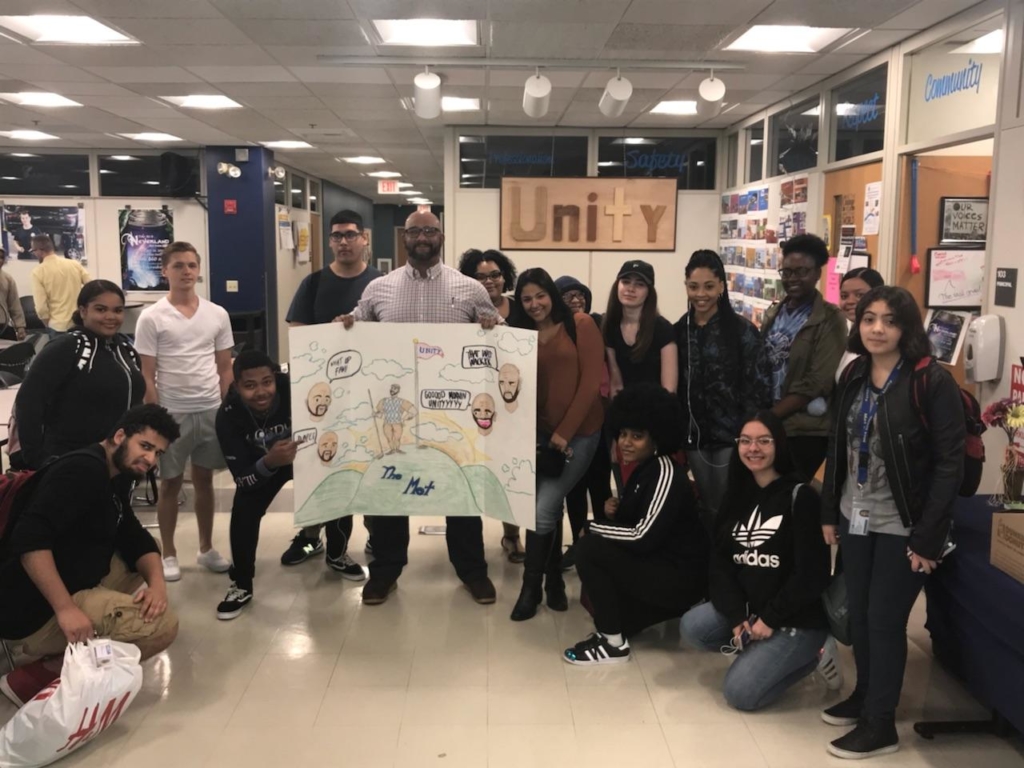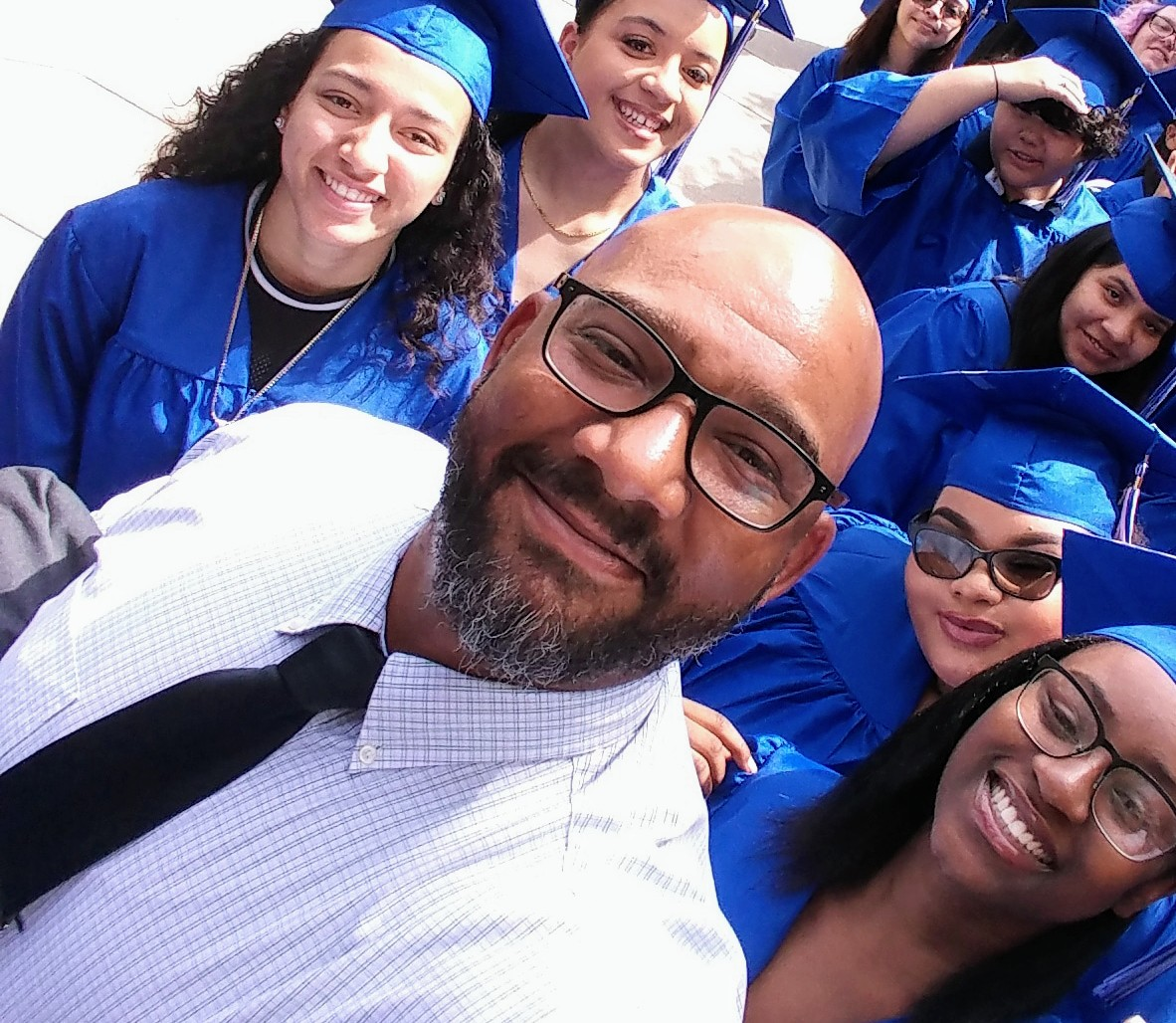As an adult, it’s really jarring for me to reflect on the fact that none of my teachers valued what I was learning outside of the classroom.
Alin Bennett, Vice President of Practice and Field Advancement, Education Reimagined
Q: Can you tell us about your experience growing up in Rhode Island?
Alin: I come from a military family—both my mom and dad served. We moved around a lot, but we eventually settled in Providence, Rhode Island after my parents divorced (my mother is originally from right outside of Providence). Providence is where I spent most of my childhood.
In the eighties and early nineties, Providence, like a lot of the Northeast, was economically depressed. Though, as a child, I never saw it as a depressed city. I remember a strong network of Black and Brown community-based organizations and vibrant African-American, Dominican, and Puerto Rican communities, especially in the south and west sides of the city. I also remember the availability of many community resources that originated from the heavily Catholic populations of Italian and Portuguese immigrants that arrived in the early 20th Century.
Over time, many of the faith-based social services slowly transitioned to being more secular, and now the YMCA, Boys and Girls Clubs of America, Boy Scouts of America, and Girl Scouts of America all have huge footprints across Rhode Island, in addition to a large Little League Sports culture.
I had access to all of these rich community resources that were juxtaposed against a really struggling local education system, which I don’t believe has ever really improved.
Q: How did that divergence between community resources and school resources affect your experience as a young learner?
Alin: I was good at playing the game of school. I was always a good student: I was compliant, enjoyed my lessons, and focused on pleasing my teachers and mother by doing well. But, that was all I was “known” for—being a good student, having great attendance, and the memorization of facts that I could regurgitate back to my teachers on worksheets, quizzes, and other assessments.
It was like existing in two worlds at once. Outside of school, I had a rich learning experience in the community (I was involved with every one of the community organizations I mentioned), but that experience was completely siloed from my conventional educational experience, which made me sad. And, as an adult, it’s really jarring for me to reflect on the fact that none of my teachers valued what I was learning outside of the classroom.
Q: Why is it important for young people to be known?
Alin: When I was at the Boys and Girls clubs, the Federal Hill House, or the YMCA, I felt seen. My entire family—my mom, little brother, and me were known by those community agencies. I just had a different feeling when I walked into one of those places; it brought me a lot of joy knowing that I was going to be served in a way that centered my identity, aspirations, and needs as a young learner.
I had a similar feeling when I transitioned to my magnet school, where one of the hallmarks of the program was keeping the same teachers throughout your experience. It was the perfect example of how being known can be multifaceted. Those teachers knew my strengths, learning needs, and my family dynamics, successes, and struggles. It was one of the few times in my life when I remember genuinely enjoying learning.
For young people, like me, whose lived experiences are filled with family trauma and the institutional trauma caused by poverty and a lack of access to resources, it’s important to remove the barriers that prevent them from feeling safe, loved, and knowing their basic needs are being met. That has to come before they begin understanding their learning needs and strengths.
When you walk into a space and you’re not known, it can take a long time for that barrier to be broken down, and for you to be able to access that part of yourself that wholly embraces learning. It’s extremely important to put the theory of Maslow over Blooms into practice, which prioritizes your human needs over academic ones.
Being known results in feelings of safety and belonging and removes the natural barriers that your body, emotions, and mind put up in its absence. That allows you to dive into real authentic learning about yourself and the world around you.
Q: And, what happened when you were pulled from those spaces, later in your education, where you felt known?
Alin: When we left Providence to return to my mom’s hometown of Coventry, Rhode Island, which was a heavily suburban/rural, white place, I remember falling out of love with learning. I was put right back into a very conventional education system and nosedived as a learner.
I was maintaining my grades, but I was back to playing the same game again. I also felt alienated as one of the few people of color in our community. I was missing the feeling of being around people who looked like me and had similar life experiences.
It took a long time to find myself again, which didn’t happen until I enrolled at Rhode Island College. The college’s program is very engaging and learner-centered, at least as much as it can be within the guidelines of the institution. I was able to create my own major and select from a diversity of options in my history and education double major. And, the education program was very progressive and pushed to change the conventional paradigm.
That’s where I started to find myself and re-engage in my learning in an environment that was very diverse. I was very involved in ALLIED, which was a group of Black, Brown, and Indigenous people trying to diversify the education field. Doing that work, I found myself loving learning again. I was connected to an equity-driven community full of people with shared experiences.
Q: Where did your renewed love of learning lead you?
Alin: Right after I finished my undergraduate degrees, I traveled to the UK to support curriculum work for an equity-centered project in Northern England, right outside of Manchester. The goal was to diversify a very Anglocentric curriculum and help incorporate many of the aspects of the five elements we point to at Education Reimagined.
We were creating their version of an advisory system that included developing an internship program and reimagining their age-based cohorts—organized on ability, interest, and other factors.
That work deepened my commitment to equity and pushed me to reflect on my own experiences as a learner. Specifically, the educational opportunities I had access to during my 10 years of college (undergraduate and graduate) that completely differed from what some of my friends in the states were experiencing.
My conversations with those friends revealed the vast divide between those in conventional education programs and folks in programs that are moving toward being learner-centered.
Fast forward to the end of my experience in the UK, my flatmate, who was working at a Big Picture Learning school in Amsterdam, told me Big Picture Learning started in Providence. I had never heard of it, so I did my research and, within a week, I was on the phone with them. Patty Holiday walked me through their system and I immediately knew it was where I needed to go.
Q: Did you feel prepared to fully dive into a fully learner-centered space?
Alin: At the Met High School, it was jarring for me at first when I started grappling with what it means to be immersed in a learner-centered environment and directly supporting the systems and structures that allow for learner-centeredness to thrive.
As a practitioner, it takes a lot of adjustment to get orientated. In the previous paradigm, I saw myself as a leader whose job it was to find ways to engage learners in certain content I valued or deemed important. In this new paradigm, I learned it was about filling a learner’s bucket with the information they needed to be successful, in a very individualized way.
The biggest shift for me was seeing my role as that of an educator who is there to spark a learner’s fire. I was now focused on supporting learners to know themselves enough to discover what uniquely stoked their inner fire and then at the point where they are fully engaged, empower them to ignite it from within.
Ironically, I was seeing what I wanted for myself as a kid, which was a whole child approach to learning that valued all the experiences young people have outside of school. I welcomed, even begged, them to bring those experiences into the classroom and use them to fuel their fire for learning.
Q: If you were building a learner-centered community from the ground up, where would you start?
Alin: I would start by thinking about when I had access to the most powerful learner-centered experiences, which were often the result of one of several things: my mom’s advocacy, my own advocacy, the experiences I sought out as an adult, or just pure luck.
In my design, the first aspect would be ensuring that folks don’t have to rely on luck or their own social capital to access all the opportunities that I had as a young person. Access to those opportunities would be the default setting. It’s very easy for a parent to enroll their child in a conventional educational system. It should be just as easy to enroll them in a more learner-centered environment.
The second aspect would be making their enrollment more closely tied to all of the other agencies that supported me as a young person such as the Boys and Girls Clubs.
In Rhode Island, they are beginning to credentialize so much of the stuff that kids are doing outside of school through their Extended Learning Opportunity Initiative, which is really exciting. My design would build on that trend.
That tighter collaboration between the school and the community would be critical. We would see learning as happening after school, before school, and during the summer. It would be one interconnected infrastructure, similar to the online dashboard the Extended Learning Opportunity Initiative makes available to young people. A parent signs up a learner, that information goes into the school system, and learners get credit for it.
I would want a similar system that is known by parents, easily accessible and navigable, and inclusive of a statewide listing of opportunities that connect right back to your home base, whether that’s a physical school, homeschool, or unity center.
This all connects back to the reason why those community experiences were so valuable to me.
Growing up, the people running those community entities were a block over from where we lived, if not my direct neighbors. They knew my mom, they looked like me, and they had very similar lived-experiences.
The paradigm we’ve created for education and educators causes adults to see their role as separate from having a really deep knowledge of the people they serve. That’s never been the paradigm for community-based organizations. They are there to support people and families, in a very multifaceted and individualized way. That’s what I envision for any learner-centered community I would bring to life.
The last aspect would be to reimagine the use of time. We wouldn’t be restricted within a six-hour period. If a learner is interested in robotics and wants to leave their home base to explore that after lunch, they can do so. They also may decide the space where they do robotics is where they want to study science for an entire quarter or semester. There’s so much to access in a community, and I’d give learners the freedom to access it all.

